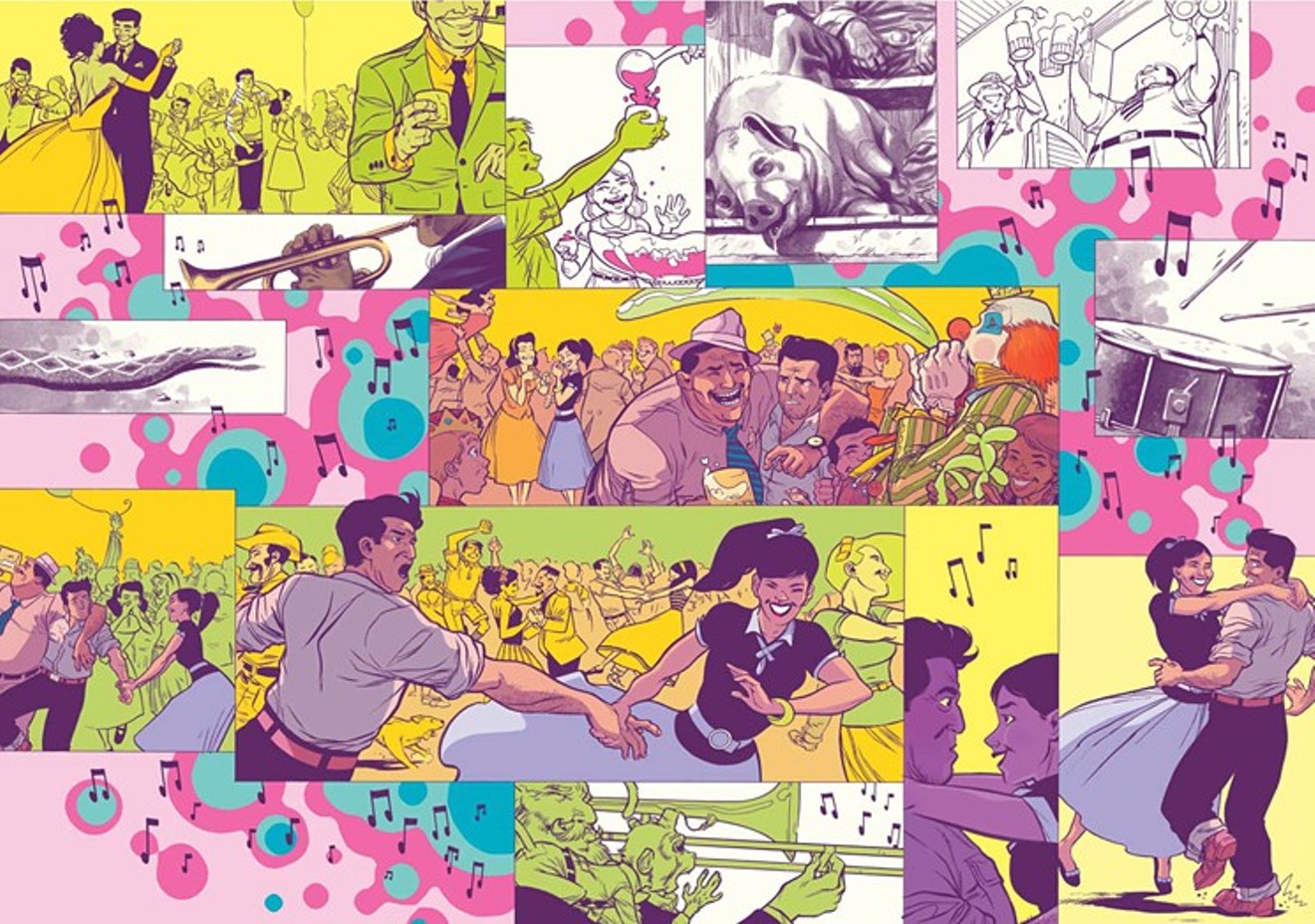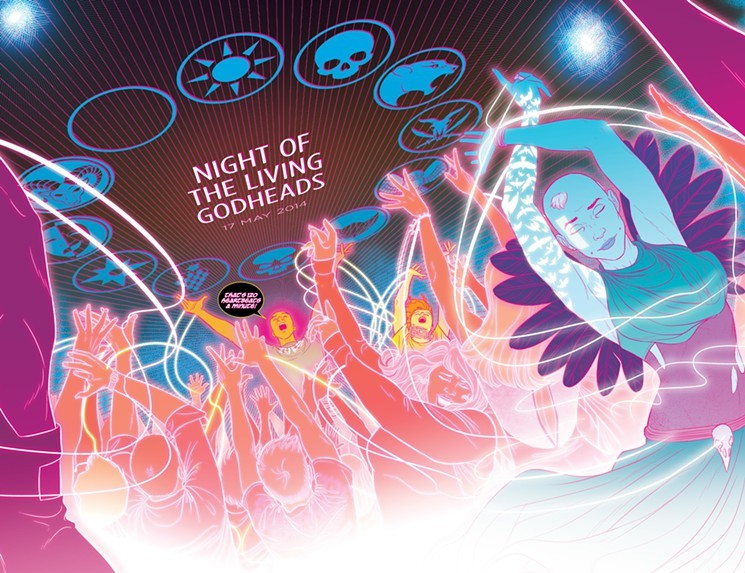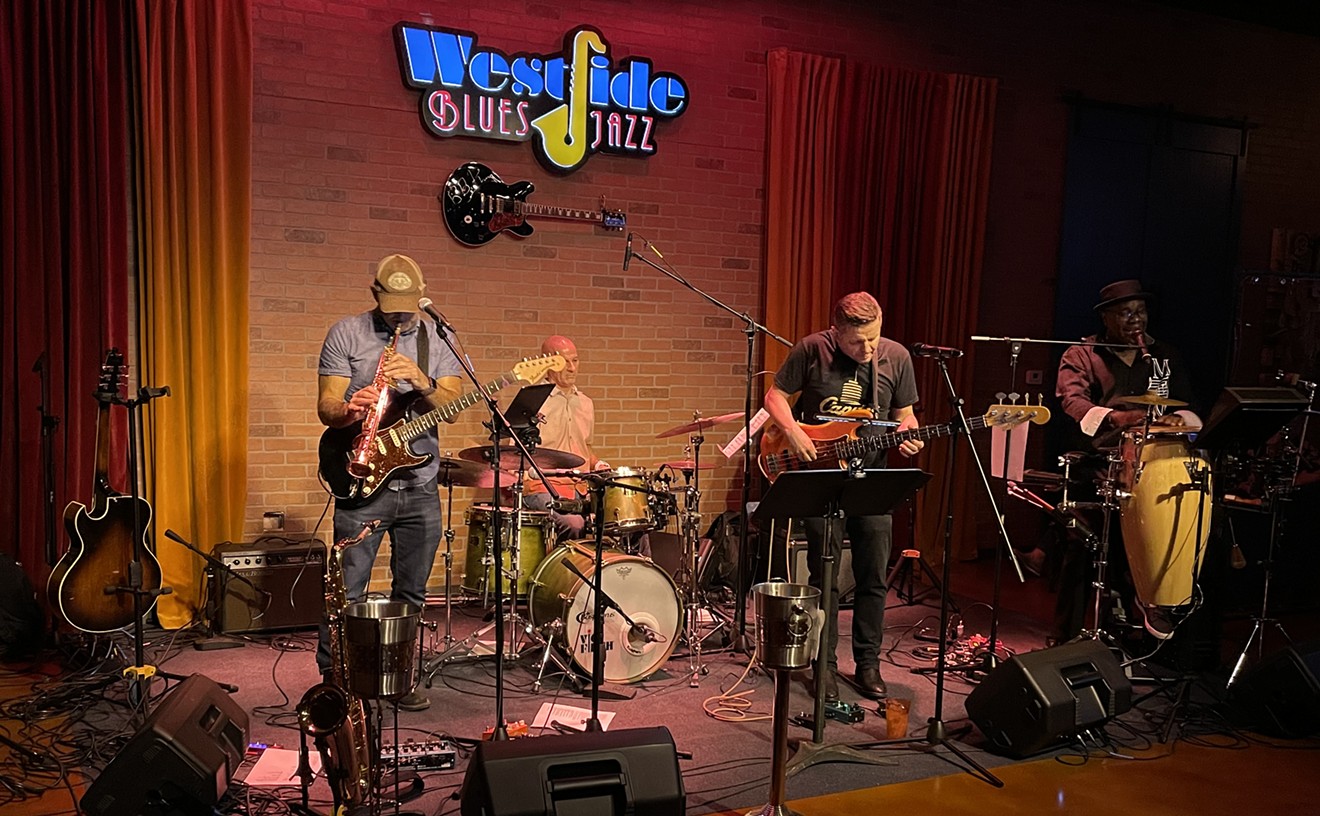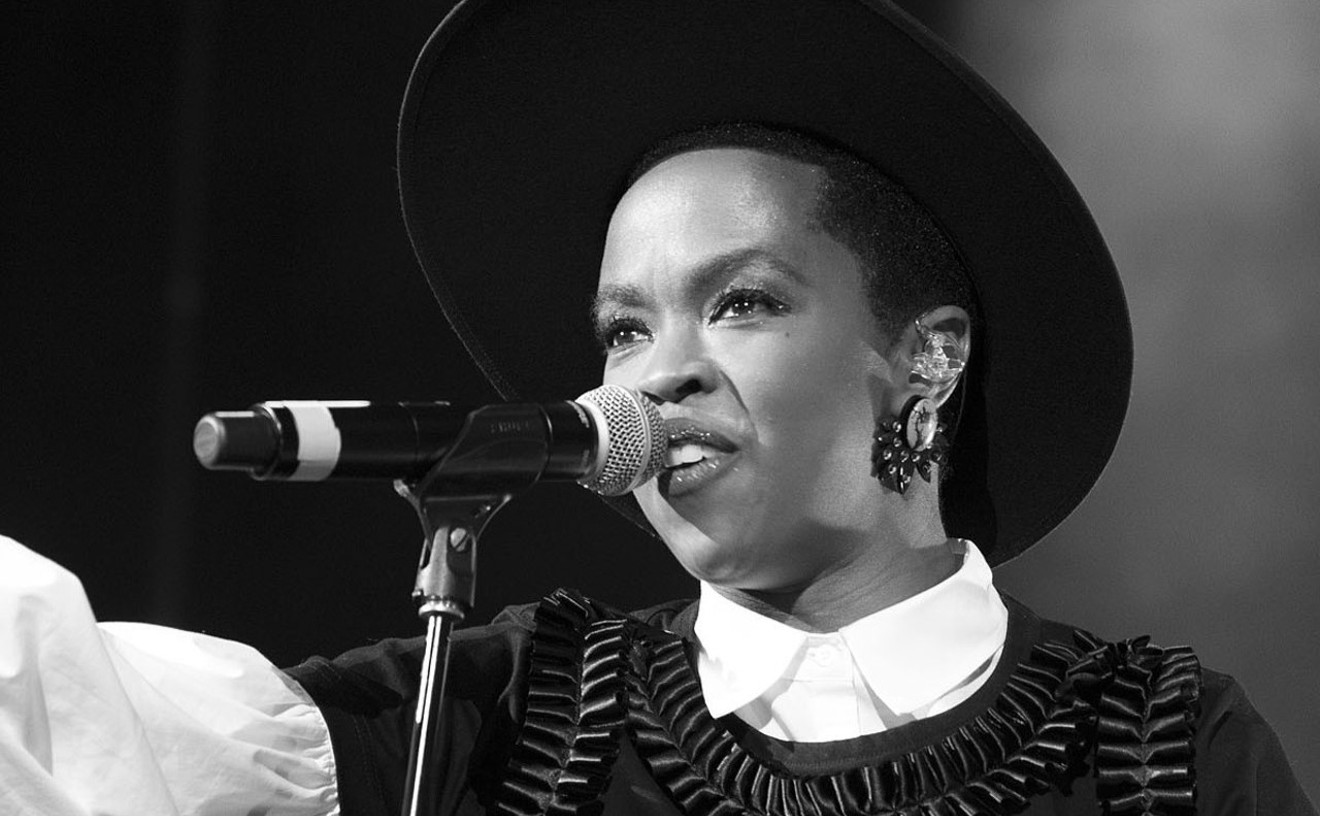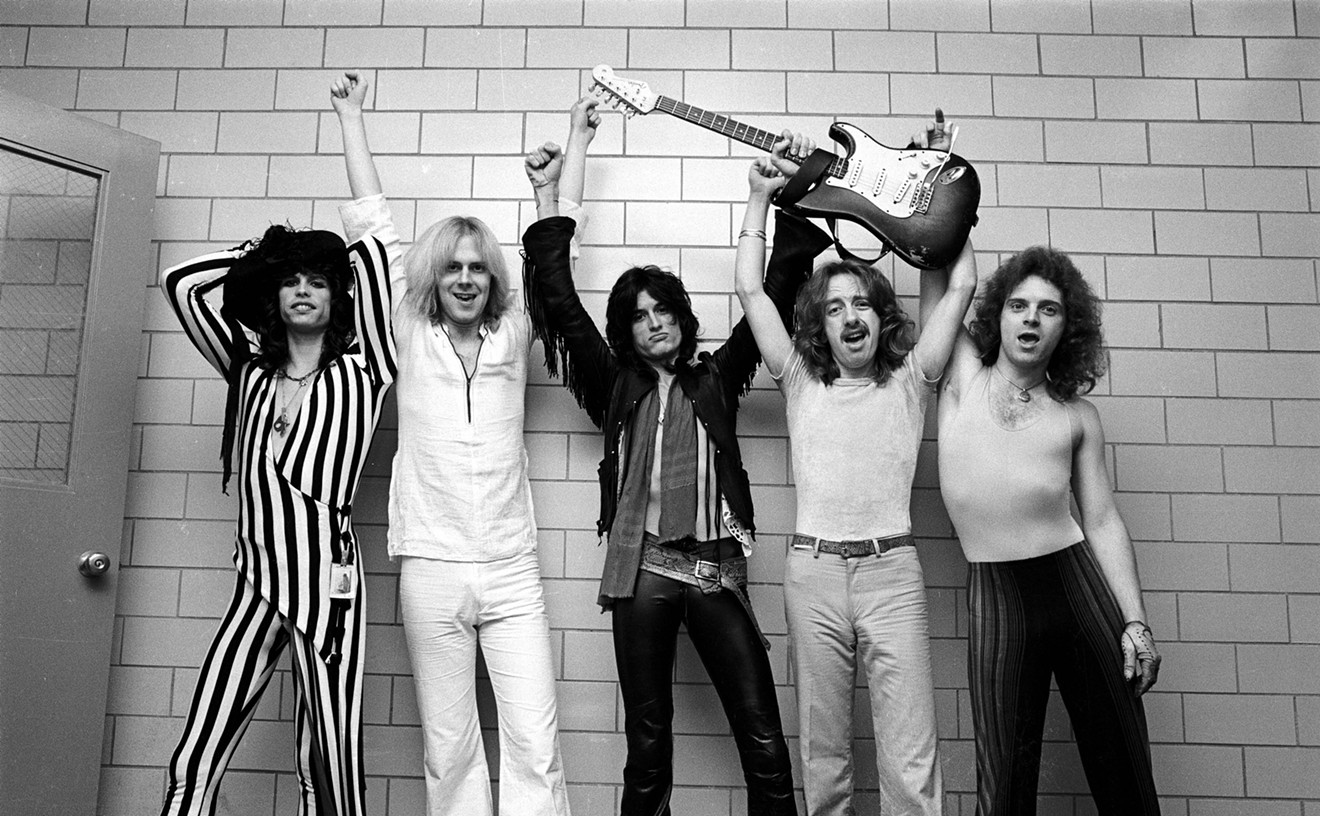Music is versatile in that it can be independent in and of itself as a piece of art. But in tandem with certain mediums, such as film or television, the perfect composition or the right song choice on the soundtrack can create powerful moments.
Comics are versatile in that they combine the interaction and pacing of reading with the visual storytelling that can only be achieved in the medium. Comics can mimic film and vice-versa, yet both excel when embracing their own tenets.
But the combination of music and comics? It’s a tough one to crack.
Due to the strictly visual nature of comics' storytelling, it’s hard to capture auditory concepts. How is an artist supposed to convey the beat of a song? In the wrong hands, music in comics — be it a band performance or a radio playing a song — is just an ill-fated effort to print some lyrics.
Some comics, however, do it right and they do it damn well. Music is not just something to experiment with in these stories. It is a vital component of the comics themselves. Here are a few comics about music that you need to read.
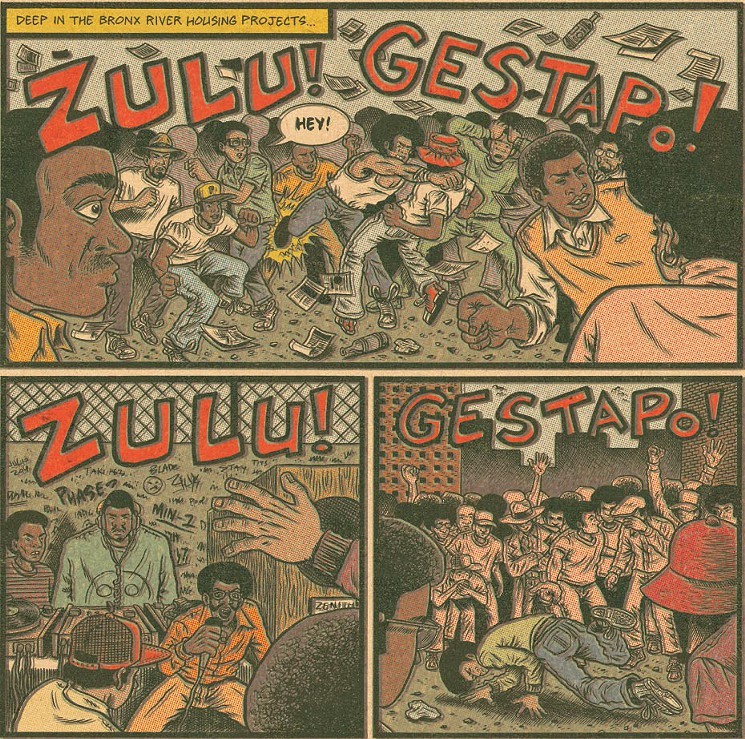
Piskor's unique cartooning style takes obvious influences from Jack Kirby and Steve Ditko, applying their timeless storytelling skills to the history of rap music.
Art by Ed Piskor/Fantagraphics
Hip Hop Family Tree
By Ed PiskorFantagraphics
Ed Piskor’s long-running history of rap music is incomparable. His chronicles of storied rappers and pioneering DJ’s is better than a Baz Luhrmann fever dream (and more accurate). The genre’s beginnings, captured in Piskor’s original style, provide a wholly unique rendition of history fitting for one of the most stylish and relevant music genres today.
The title originally carried the subtitle “A Look Into the Viral Propagation of a Culture,” an honest assessment of rap music’s ascension. While the original comics can still be found on Boing Boing the comics were printed in four oversized treasury editions by Fantagraphics.
Piskor has given rendition to the history from the 1970s all the way up to 1985, when hip-hop’s identity began to solidify as an artform. The way he captures the energy of the music — and the movement — has earned him critical acclaim and Eisner awards to match.
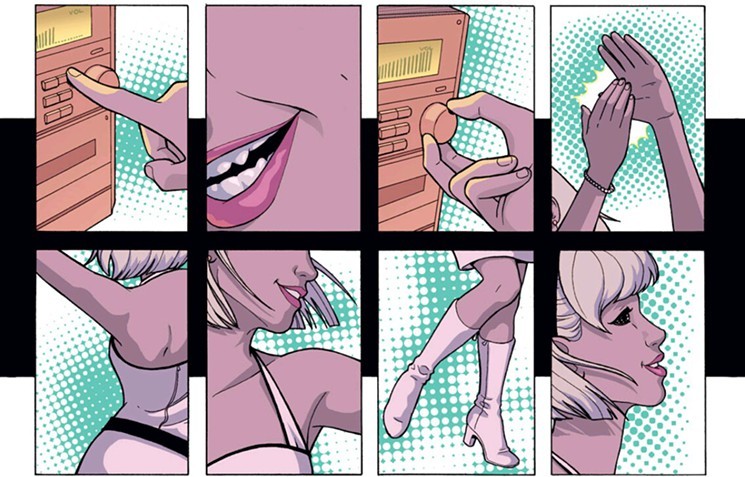
Penny B. dances to the music, like other "phonomancers" who derive their powers from sound.
Art by Jamie McKelvie and Matt Wilson/Image Comics
Phonogram
By Jamie McKelvie, Matt Wilson, and Kieron GillenImage Comics
Whenever the words “music” and “comics” are mentioned in the same sentence, a comic by Kieron Gillen, Jamie McKelvie, and Matt Wilson (who joins the team on volume 2) is not far behind. One of their first collaborations, Phonogram, is beloved among their die-hard fans.
The three-volume series began with Rue Brittania, then the Singles Club, and finally the Immaterial Girl. It tells the story of phonomancers, which is just a fancy term for “wizard with music,” and how those magicians use their powers.
And while the visual depiction of the magic is a sight to behold itself, McKelvie and Wilson’s use of music is deftly applied in other scenes, such as this scene of Penny B. dancing to the radio.
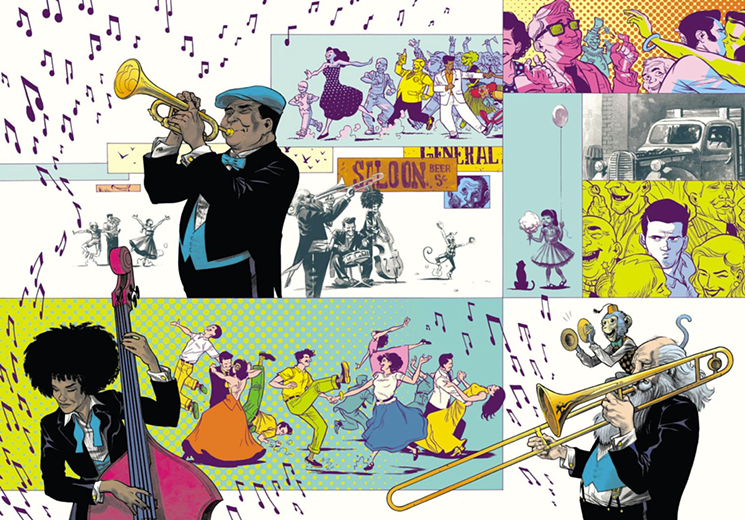
One of many amazing splash pages in this beautiful adaptation of a once thought-lost screenplay from Jim Henson.
Art by Ramón K. Pérez/Boom! Studios
Jim Henson's Tale of Sand
By Ramón K. PérezBoom! Studios
Tale of Sand, Jim Henson’s screenplay written before Muppeteering took off, was considered a lost opportunity in the years after his death. But Archaia, a publishing line known for giving auteurs and creators unfettered artistic freedom, found the perfect cartoonist to capture Henson’s trademark sensibilities. (Archaia is now an imprint of Boom! Studios.)
Ramon Perez earned industry acclaim with his work on this graphic novel, later working for Marvel on characters like the X-Men and Hawkeye. His wonderful two-page spreads made him perfect for superhero comics, but his depictions of music and dancing are better than his bombastic brawls between superpowers.
The surrealist journey across the desert begins with Mac in a small western town on the eve of his journey. He attempts to navigate through a swing party, where it seems all of the town’s denizens are dancing about, and gets roped into the festivities. Trumpets and stand-up bass tones carry music throughout the pages, giving a glimpse into the easygoing chaos of the town party.
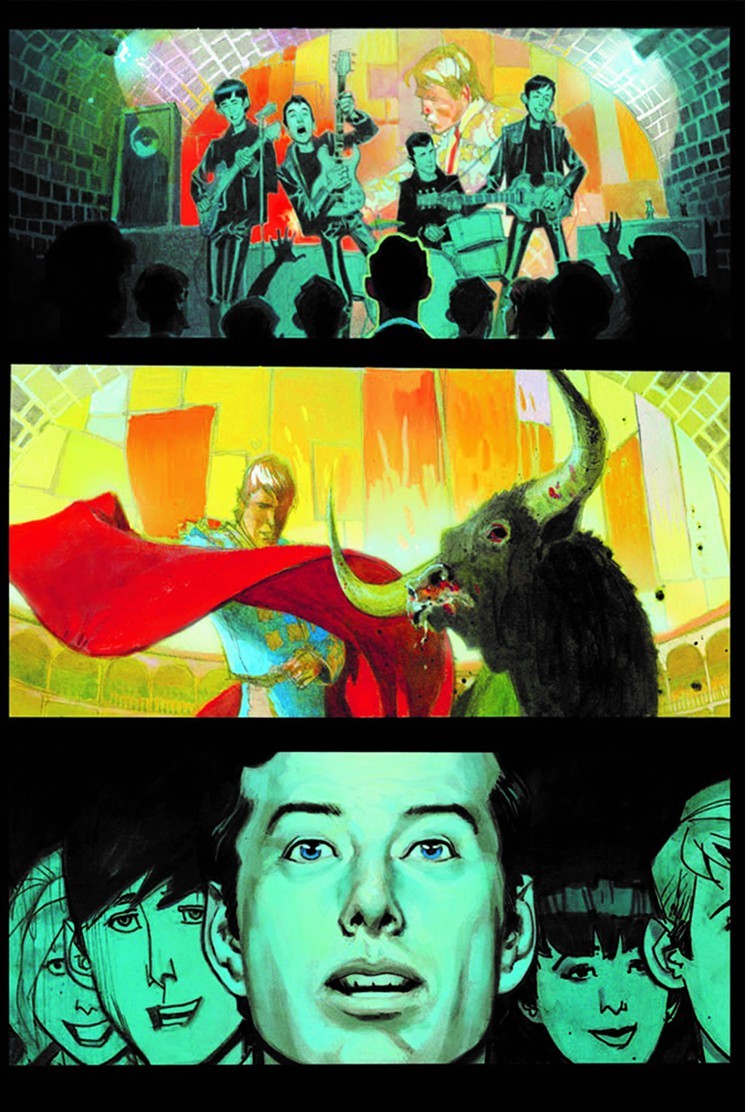
Brian Epstein watches in awe as the Beatles perform in Liverpool, juxtaposed with images of a bullfighter.
Art by Andrew Robinson/Dark Horse
The Fifth Beatle
By Andrew Robinson, Viviek Tiwary, and Kyle BakerDark Horse
The story of Brian Epstein is one of the music industry’s worst kept secrets. The true history of the Beatles’ manager (and titular ‘Fifth Beatle’), Epstein battled awful TV executives, drug addiction, and anxiety in his time managing the supergroup.
While the story is about how Epstein discovered and subsequently managed the Beatles’ early formative years, Andrew Robinson’s artwork perfect captures the awe and inspiration of a live performance.
As Epstein watches the Fab Four play underground in a Liverpool club, he is struck. The presentation and the energy of their performance resonates powerfully with him, evoking visions of a matador dueling a bull until one of them is defeated. Epstein is the bull, and he has no choice in the matter. He’s swept away.
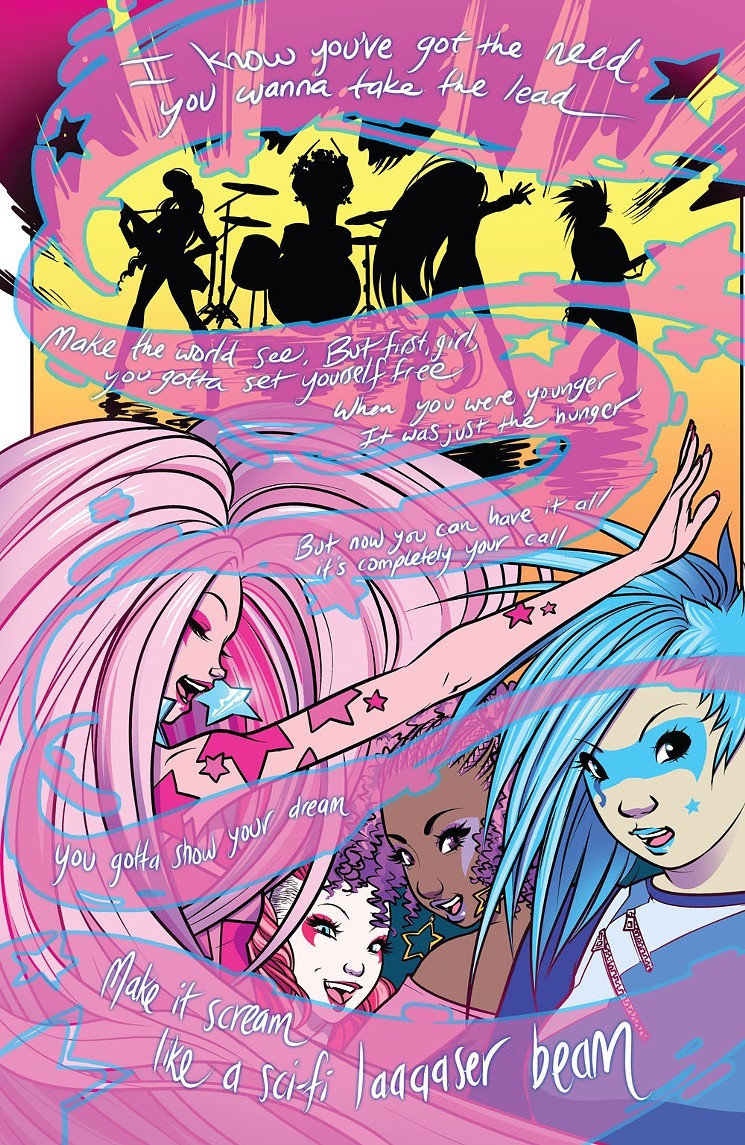
While the new film and old cartoon might not be for every fan, the comic book version of Jem and the Holograms is essential reading for even the most casual reader.
Art by Sophie Campbell and M. Victoria Robado/IDW
Jem and the Holograms
By Sophie Campbell, M. Victoria Robado, and Kelly ThompsonIDW
Sophie Campbell has made a name doing Teenage Mutant Ninja Turtles comics as well as her own Wet Moon series, but she's also handled the interiors of IDW’s fantastic licensed comic book, Jem and the Holograms.
M. Victoria Robado provides color art for the comic, collaborating with Campbell to provide the music with a textured presence. While the lyrics are showcased as a part of the artwork, it's not the lettering of the lyrics that make it stand out. The layouts and the focus of each panel give every band member attention, whether they be in the Holograms or their rivals, the Misfits.
The resulting splash pages are dynamic and energetic, capturing the energy of a '80s glam-rock performance in an elegant comic book spread. IDW surrounded writer Kelly Thompson with immense talent for their riff on Jerica & Co., providing a portrayal of the old cartoon characters in a light that anyone can enjoy.
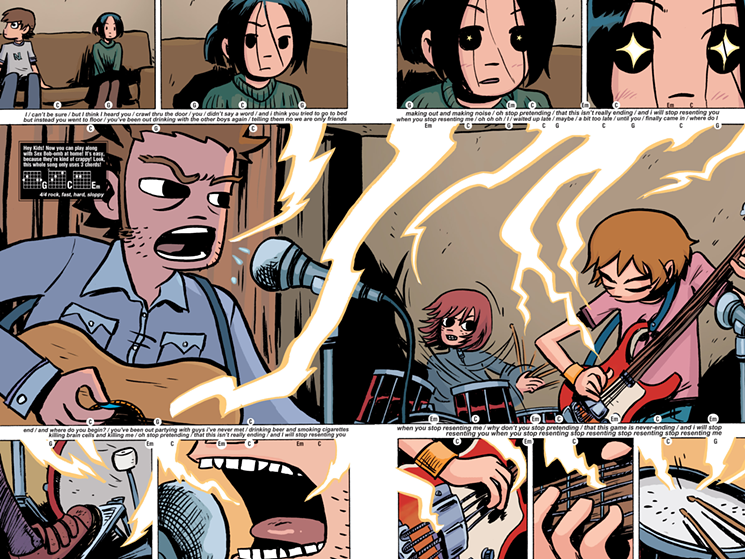
O'Malley proves he's a master cartoonist with two pages.
Art by Bryan Lee O'Malley and Nathan Fairbairn/Oni Press
Scott Pilgrim
By Bryan Lee O'Malley (with colors by Nathan Fairbairn)Oni Press
Scott Pilgrim, which begins with title character’s Precious Little Life and ends with his Finest Hour, is a frenetic encapsulation of a generation. While it touched on everything in pop culture from comics to movies and games, the depiction of Scott's band, Sex Bob-omb, is one of the best aspect of this series.
The garage band is portrayed to great effect. Their first practice in the book, witnessed by budding fan Knives Chau, showcases the band members equally as energy and lightning crackle from their instruments.
The tabs at the top of the page and the lyrics in the gutters of the panels add a level of realism not found in most comics, giving ample material for the musically inclined to create the song in their own heads.
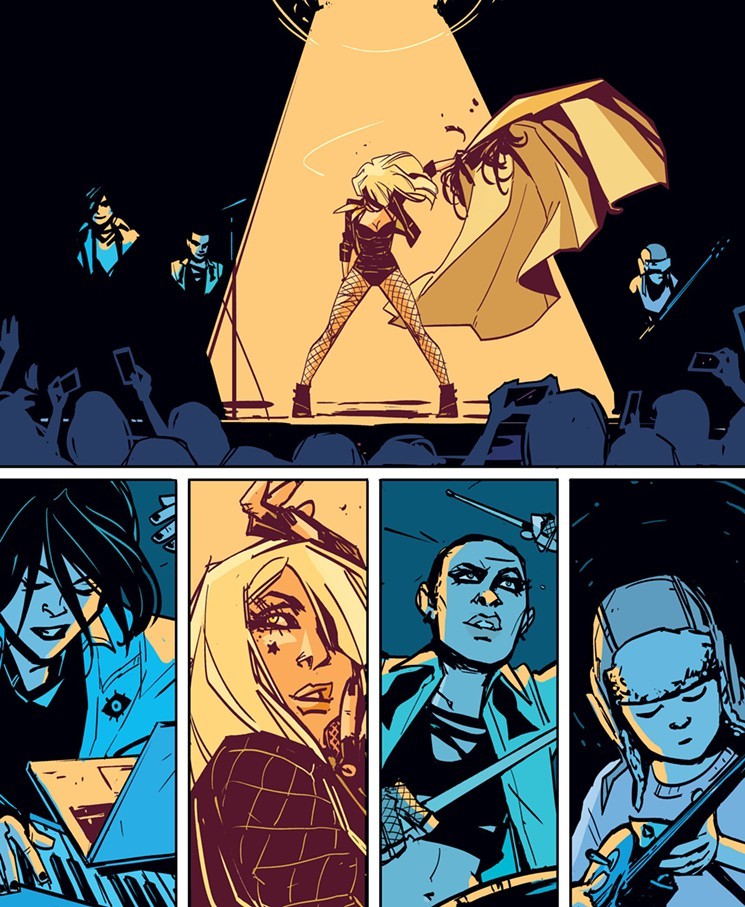
Finally, a fitting use for Black Canary's super-powered vocal chords.
Art by Annie Wu and Lee Loughridge/DC Comics
Black Canary
By Annie Wu, Brendan Fletcher, and Cameron StewartDC Comics
While Dinah Lance has been portrayed as an attorney, a ninja, and a costumed crime-fighter in the past, it’s pretty insane that a character with super-sonic vocal chords never actually utilized them for a profession.
But then, comic artist Annie Wu teamed up with Cameron Stewart and Brendan Fletcher to put Dinah on the run, joining an obscure punk band in need of a lead singer, and touring the road. It’s a concept that fit perfectly into superhero comics, combining style and aesthetic with a punchy story about a band becoming a family.
The concert scenes are frenetic; they music leaps off the page and smacks you in the face, leaving you in a daze as the ladies of Black Canary rock out.
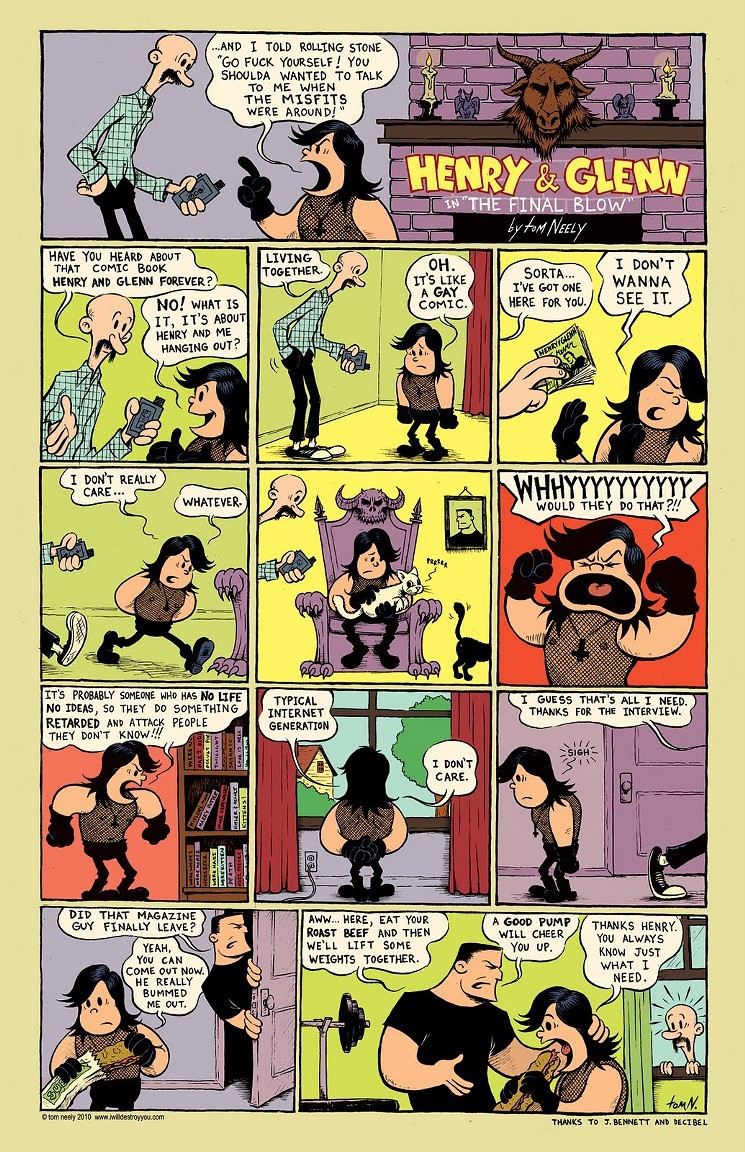
While this comic is not a typical portrayal of music, it's endearingly charming depictions of punk rock royalty is enough for anyone to enjoy.
Art by Tom Neely
Henry & Glenn Forever
By Tom NeelyMicrocosm Publishing
This comic is less about music and more about two musical giants finding love and friendship in unlikely places. The story is essentially visualized fan-fiction, depicting various adventures the experienced punk singers probably never had.
Henry & Glenn Forever depicts Henry Rollins and Glenn Danzig doing ... well, they do a bunch of shit. Created by Tom Neely (writer of The Humans, another bad-ass comic), Glenn and Henry deal with many relationship problems typical among sitcoms.
It's not really a great depiction of music, per se, but a great hypothetical love story between two of punk’s most influential figures.
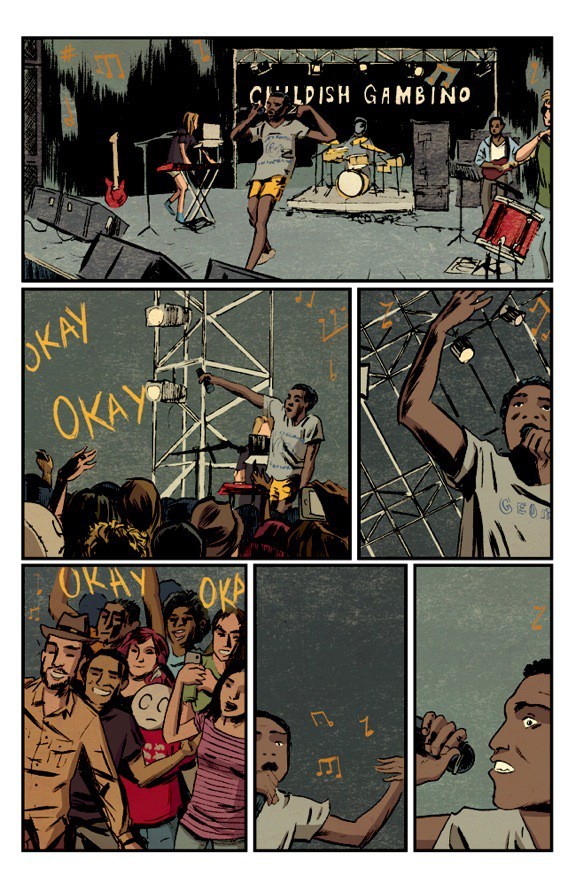
Childish Gambino (a.k.a. Donald Glover) makes a guest appearance in this issue of Li'l Depressed Boy, which is as much about music and concerts as it is about being awkward at parties.
Art by Sina Grace/Image Comics
Li'l Depressed Boy
By S. Steven Struble and Sina GraceImage Comics
Sina Grace is known for autobiographical comics about the dicks he’s sucked and the shit he’s spent money on, but one of his most known contributions is to the long-running series about a plain, stick figure kid in a fully realized world.
The comic makes frequent use of music, whether LDB is at a record store looking for new tunes or on an awkward maybe-date at a Childish Gambino show.
Li'l Depressed Boy depends somewhat on the reader’s familiarity with modern music, taking heavy inspiration from Los Angeles’ live music scene. The depictions of clubs and contemporary acts supplement the series, giving this slice-of-life story about a plain cartoon character a degree of realism.
The Wicked + the Divine
By Jamie McKelvie, Matt Wilson, and Kieron GillenImage Comics
McKelvie and Gillen are so good with their music depictions, they manage to get on this list twice. While Phonogram deals with the concept of music more explicitly, it remains as a backbone to everything occurring in Wic+Div, as it’s fans affectionately refer to it.
Every 90 years, gods across all pantheons are “awoken” in the bodies of teenagers. This is the first occurrence in the modern age, making these gods revered as rock and pop stars akin to Drake, Rihanna, Taylor Swift, etc.
The gods even perform shows for their adoring believers and fans, creating a light-show spectacle that only two tabs of LSD and a Pink Floyd planetarium show could provide. The “music” is depicted in gorgeous splashes of colors and lights. McKelvie frames the scenes, but Matt Wilson’s color art does the heavy lifting in these sequences.
This article originally appeared in 2016 and has been updated.

